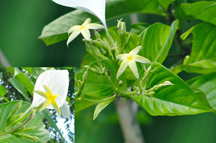Barcodes for plant biodiversity
|

|
Thomasian researchers use modern phylogenetic tools to unravel the diversity of Philippine Flora
 The Thomasian Angiosperm Phylogeny and Barcoding Group (TAPBG) headed by Prof. Dr. Grecebio Jonathan D. Alejandro, represents the Plant Biodiversity studies at the UST-RCNAS. The group is recognized in pioneering efforts on Plant Molecular Phylogenetics in the Philippines and discovery of novel plant taxa mostly in the family Rubiaceae. The Thomasian Angiosperm Phylogeny and Barcoding Group (TAPBG) headed by Prof. Dr. Grecebio Jonathan D. Alejandro, represents the Plant Biodiversity studies at the UST-RCNAS. The group is recognized in pioneering efforts on Plant Molecular Phylogenetics in the Philippines and discovery of novel plant taxa mostly in the family Rubiaceae.
The TAPBG uses both classical tools and molecular markers (cpDNA & nrDNA) in resolving taxonomic uncertainties in Rubiaceae and endemic plants of other families such as Apocynaceae-Asclepiadoideae, Annonaceae, Rutaceae, and Sapindaceae. The very first step towards a comprehensive treatment of Rubiaceae (4th largest Angiosperm family) for the Flora of the Philippines project has been taken in DELTA format available at http://www.bio.uni-bayreuth.de/planta2/research/databases/delta_ru/index.htm. Several species-rich genera of Philippine Rubiaceae need revision and numerous endemic species are left unresolved and awaiting to be discovered. In Rubiaceae, the group has published taxonomic revisions and molecular phylogenetic studies in the tribe Mussandeae and endemic Philippine genera (Antherostele, Greeniopsis, and Villaria). The work on the molecular phylogeny of the tribe Mussaendeae recognized a new delimitation and origin of the genus Mussaenda, established a new genus Bremeria including 19 new combinations, and four new species and a variety of Philippine Mussaenda. One of the new Mussaenda species was named after UST. Other published new species as contributions to the Philippine's biodiversity include: Antherostele samarensis, Bikkia redondoensis, Villaria leytensis, Villaria uniflora (all in Rubiaceae), and Uvaria valderramensis (Annonaceae). Several synonymy and new combinations were also published in Canthium, Keetia, Psydrax, Pyrostria, Rothmannia, Severinia, Currently, the TAPBG is working on the following genera (Antirhea, Canthium, Diplospora,Discospermum, Guettarda, Guettardella, Hypobathrum, Ixora, Tricalysia, etc. )
Furthermore, the group takes a particular effort to document biodiversity of Philippine Rubiaceae in several forests for the Flora of the Philippines project and collaborative studies on the Phytochemistry and Biological Potentials of endemic and indigenous Philippine plants. Recently, the TAPBG received a research grant from the Department of Science and Technology - Philippine Council for Health Research and Development (DOST-PCHRD) for a pioneering genome-based authentication of Philippine medicinal plants with promising chemical and pharmacological property.
Selected Publications:
Alejandro, Grecebio Jonathan; Meve, Ulrich; Liede-Schumann, Sigrid. 2008. Two new species of Mussaenda (Rubiaceae) from Panay Island, Philippines BOTANICAL JOURNAL OF THE LINNEAN SOCIETY 158 (1): 87-92
Alejandro, Grecebio Jonathan D.; Meve, Ulrich; Uy, Millard; et al. 2010. Molecular support of the classification of Greeniopsis Merr.in Aleisanthieae (Rubiaceae), with a revision of the genusTAXON 59 (5): 1547-1564
Alejandro, Grecebio Jonathan D.; Meve, Ulrich; Mouly, Arnaud; et al. 2011. Molecular phylogeny and taxonomic revision of the Philippine endemic Villaria Rolfe (Rubiaceae) PLANT SYSTEMATICS AND EVOLUTION 296 (1-2): 1-20
 |
| Fig. 1. Mussaenda ustii Alejandro |
|
|